7 Weird Customs In Bali That Offer A Window Into A Meaningful Culture
Discover 7 weird customs that express the deep spirituality that weaves through Bali’s culture, highlighting the Balinese people’s devotion to harmony and balance.
Whether it’s filing down teeth or observing a day of silence where all noise is prohibited, Bali’s customs may seem unusual at first to outsiders. But a closer look at weird customs in Bali reveals that they are rich with meaning, reflecting the philosophy of Tri Hita Karana, the Three Causes of Well-Being: to live in harmony with God, nature, and other people.
Let’s explore some of the fascinating customs that make Bali such a unique and inspiring place to visit, one where your spirit can bask in a sense of balance and peace dating back centuries.
1. Tooth filing ceremony
Across the world, losing baby teeth is a rite of passage. But by the time Westerners hit puberty, rites of passage involving teeth are generally over. In Bali, it is different. Boys and girls undergo a special tooth-filing ritual known as Metatah. During the ritual, a priest files down the top front teeth.
Why front teeth? The people of Bali believe that the unfiled front teeth are animal-like. Filing them down purges the “Sad Ripu”—unwanted traits that include anger, lust, greed, confusion, jealousy, and intoxication. The person entering adulthood can thus live a more spiritual, uplifted life and find passage into the afterlife. In a sense, it is not so different from baptism in Christian traditions.
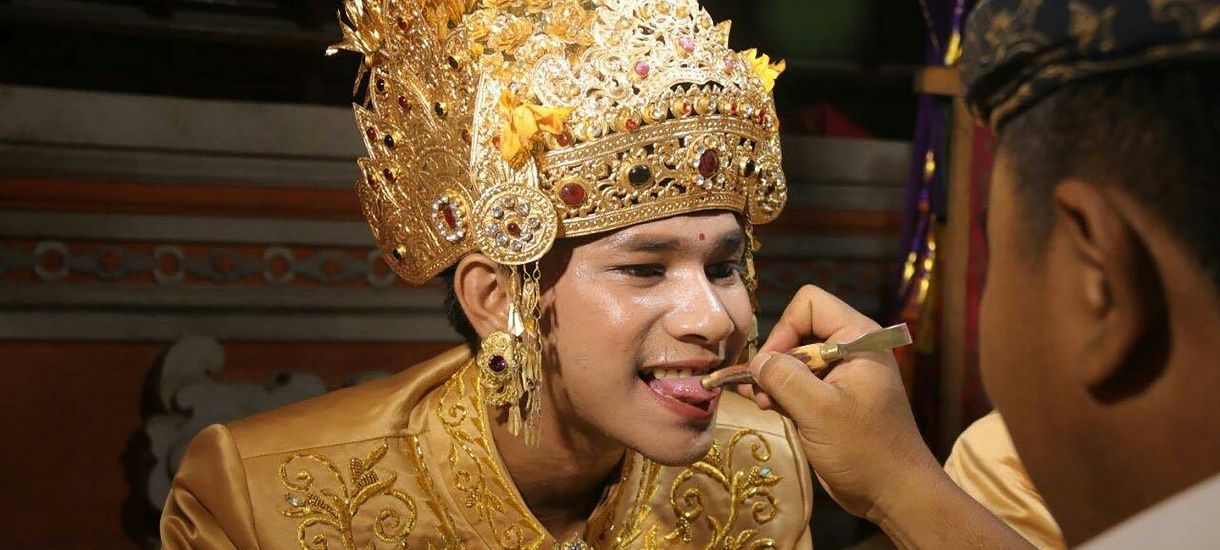
Source: Unsplash
This ritual can take place as early as the age of 6, or as late as the age of 18. Instead of choosing a particular year, the Balinese people base the timing on whether a girl or boy has undergone a physical change associated with puberty. For girls, this is usually the start of menstruation. For boys, it is typically when the voice gets deeper.
After the newly minted adult has their teeth filed, they participate in a tasting ceremony featuring sweet, sour, bitter, salty, spicy, and astringent flavors. This is a “taste” of their future journey of life in all of its variety.
If a person misses out on the ritual while alive, a priest may file down their teeth after they die. That way, they will be able to make it to heaven.
2. Baby's first laugh celebration
It’s not a child's first word or first step that holds deep significance to new parents in Bali! It's the child’s first laugh that calls for a celebration.
The belief in Bali is that the soul has not fully settled in the body when a child is born. It takes some time being in the world and experiencing it to really feel grounded and at home in a physical body.
1.jpg)
Source: Unsplash
When the baby first laughs, they are expressing delight in the world in which they’ve found themselves, which has then truly become their home.
So, like other traditions in Bali, celebrating a baby’s first laugh is deeply infused with spirituality. It symbolizes a child’s spirit embracing their new life and connecting with the world and their loved ones.
3. Silent New Year celebration
Imagine a day of total silence. No one goes out, plays music, turns on the TV, or runs their business. That is the “Day of Silence,” known locally as Nyepi. The Day of Silence takes place in March and is part of the traditional Balinese New Year’s festivals. The purpose of Nyepi is to drive away evil spirits, fast and meditate to cleanse the body and soul, and prepare for the start of a new year.
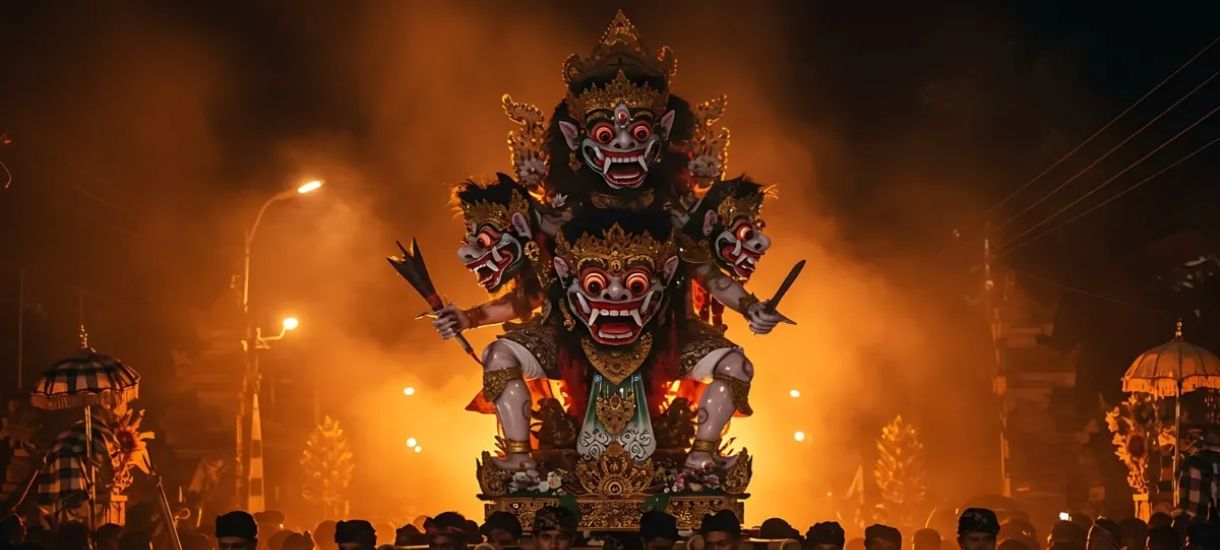
Source: Villa Kinaree Estate
During Nyepi, you will have to stay in your accommodation; if you go out, Pecalang security officers may stop you. You are forbidden from any activities that make noise. You have to make sure you’ve already stocked up on food if you don’t plan to fast, as restaurants will be closed.
With so many restrictions, why visit Bali during Nyepi? There is no traffic noise, no shouting in the streets, no sounds of civilization. If you book a room close to nature, you can sit at the window or out on your porch and hear the sounds of wind, trees, birds, and waves. It is a true case of “less is more,” filling the spirit with a sense of awe.
4. Balinese names are systematic
“What will you name your baby?” This is a question no one needs to ask in Bali. If you know how many children a couple has, you automatically know the name of their next child.
The reason is that the Balinese naming convention is systematic, and all children are named according to their birth order.
- Firstborn: Wayan, Putu, Gede, or Ni Luh
- Second-born: Made, Nengah, or Kadek
- Third-born: Komang or Nyoman
- Fourth-born: Ketut
- Fifth-born and beyond: Wayan Balik (“Wayan Again”)
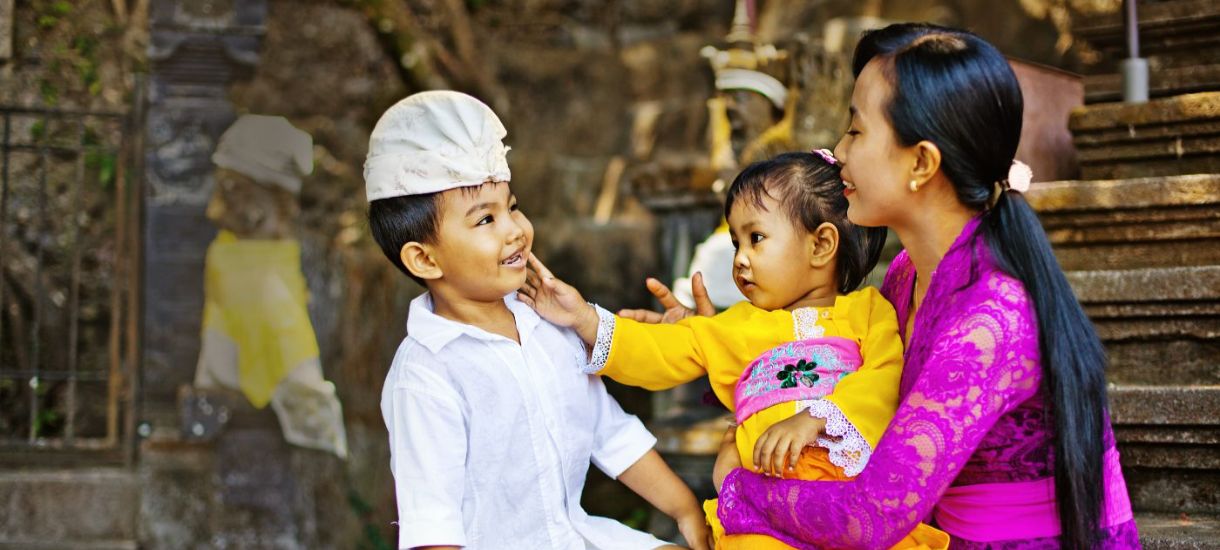
Source: Balipedia
“I” may be attached as a prefix to indicate a child is male, and “Ni” may be attached as a prefix to indicate a child is female. Sometimes a caste name may be included, but not in every case (nor is the caste system as important to Balinese people as it is to Indian people).
So, do Balinese people mix each other up all the time, referring to everyone by the same few names? No. A personal name is added after the birth order name. It usually evokes a desirable trait and is typically in Sanskrit. Examples include “Setiawan,” which means “faithful,” and “Ngurah,” which is “gift from Heaven.”
5. Balinese cremation ceremony
As you explore Bali’s towns and villages, there is a chance you might stumble upon a loud, colorful procession bearing what looks like a large statue of a bull, cow, or temple tower. When they reach a designated spot, they light the bull or tower ablaze.
What you are actually witnessing is a Balinese cremation ceremony called Ngaben. The bull, cow or tower is a coffin, sometimes for an individual, sometimes for multiple members of a community.
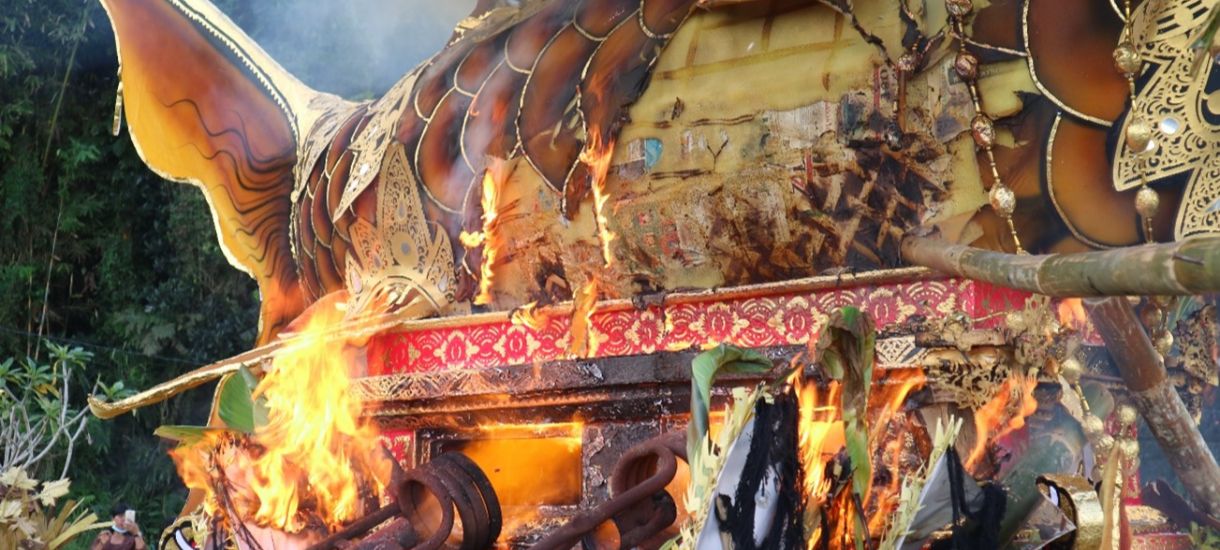
Source: Jembatan Bahasa
Balinese cremation ceremonies are very different from Western funerals. It isn’t just the chants, the music, and the elaborate coffins that set them apart; it is also their purpose.
In the West, a funeral is for the living. It is their chance to process grief together and find some closure when a loved one dies. But in Bali, the cremation ceremony is for the deceased. It is the duty of the living to cremate the body. Until that happens, the spirit is still bound to this world. As the body burns, the fire cleanses it, and the soul is released to reincarnate or achieve moksha (liberation from the cycles of rebirth).
That is why even if it takes years to save up the funds (as often happens), the cremation must happen. It is not just about closure; it is about making sure that deceased loved ones reach their destination.
6. The fire war
One of the most lively rituals you can witness in Bali is the “fire war,” known as Perang Api, Terteran, Mesabatan Api, or Siat Geni. During this ritual, young Balinese men use coconut husks to fling fire at each other. The sight of the bright sparks scattering through the smoke is mesmerizing. As the embers smolder and go dark, the men leap in and out of them, their bodies marked with soot as they throw more fire.
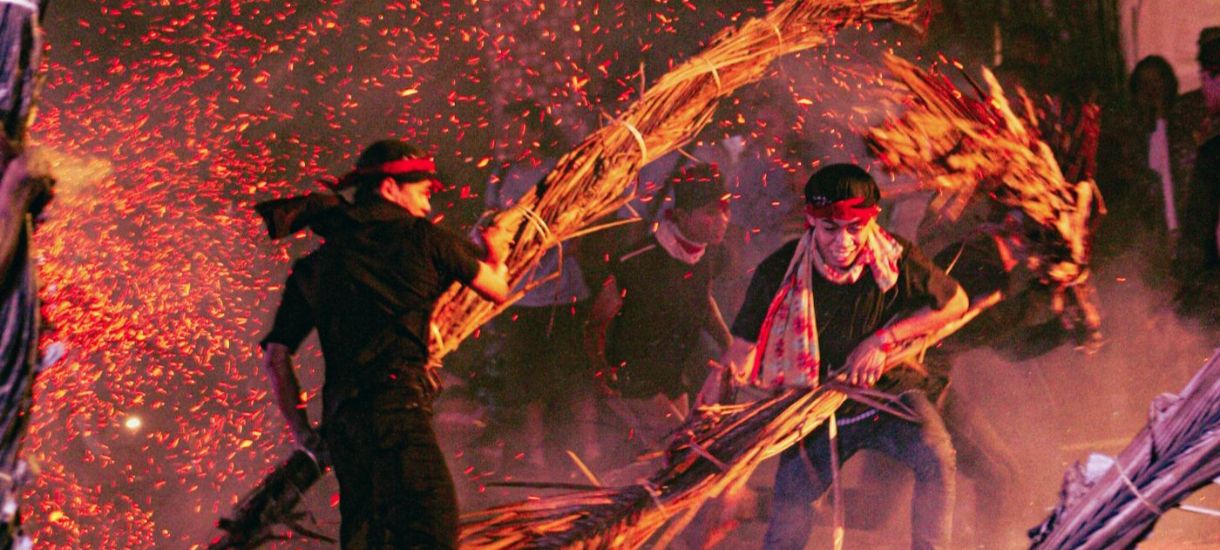
Source: Balipedia
To an outsider, this blistering spectacle may seem incomprehensible. But remember what you learned from the Balinese cremation ceremony: fire cleanses and purifies. The men participating in the fire war are ritualistically purifying their villages, freeing their family, friends and neighbors from evil influences. What might appear aggressive on the surface is actually an act of spiritual compassion to protect the community.
7. Temples of Death
Many of Bali’s beliefs and rituals feel uplifting and life-affirming. But some temples in Bali may stir up darker emotions as you are confronted by the stone visages of carved demons with bulging eyes and long, protruding tongues.
“Pura Dalem,” or “temples of death” can be found throughout Bali. These include Pura Dalem Ubud, Pura Dalem Agung Padangtegal, and the lesser-known Pura Kahyangan Jagat Bukit Dharma Durga Kutri, which is a temple dedicated directly to Durga, goddess of death.
In Hinduism, Durga is an aspect of Uma, consort of Shiva. Along with statues and reliefs depicting the goddess Durga, you will also encounter statues of her henchwoman Rangda, known as “queen of demons.”
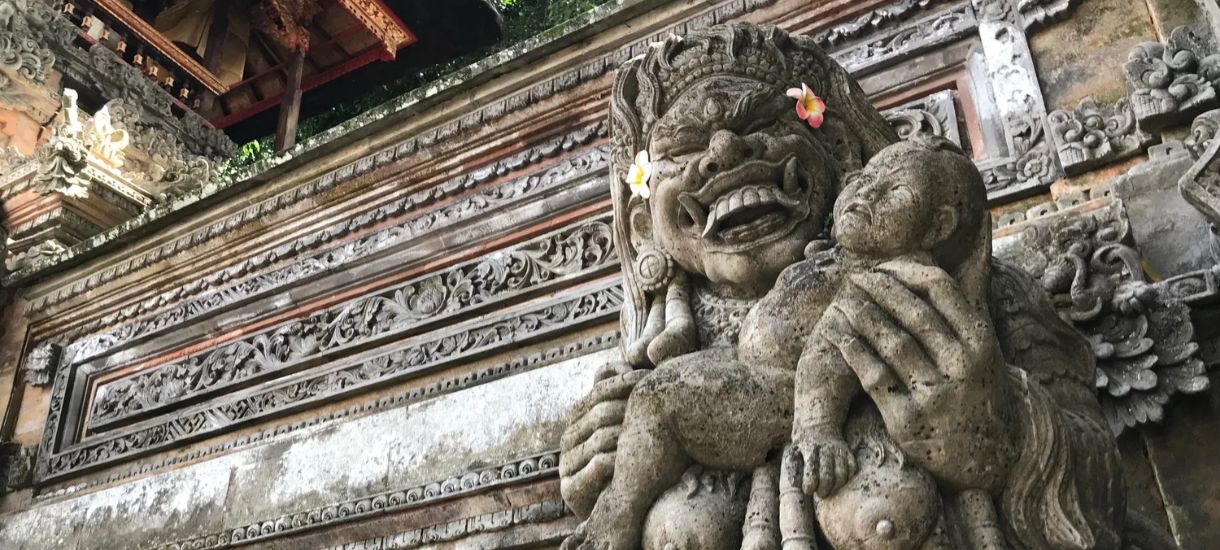
Source: The not so innocents abroad
In Hindu lore, Rangda was a princess forced into marriage and later exiled for her worship of Durga. Left for dead, she called upon Durga for aid, and later released her fury upon the world, recruiting demons and shape-shifting, plague-bearing cannibals called leyak. Statues of Rangda in the temples of death often show her cradling a baby, not to nurture it, but to devour it.
It is important to put the temples of death in context. Death and suffering are undeniable realities, and every culture and religion must find ways of reckoning with them. The people of Bali believe that all must be in balance, and that to truly appreciate the light, one must be conscious of the dark. So, even as the stone faces of demons snarl at you in the temples of death, there is goodness and beauty to be found.




